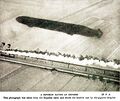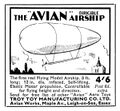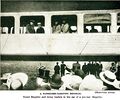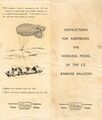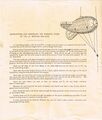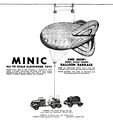Category:Balloons
Lighter-than air aircraft are typically based around the idea of one or more buoyant balloon components filled either with hot air, hydrogen, or helium. Much of the very early pioneering work on people-carrying balloons was done in France. After the advent of the Zeppelin company, Germany became the world leader in airship technology.
Scale and efficiency
The lifting power of a balloon is a function of the amount of buoyant gas enclosed, minus the infrastructure needed for containment. Fos a simple C19th silk hot-air balloon, scaled up on all three axes, the surface area is proportional to the square of a linear dimension, but the volume enclosed is proportional to the cube of the dimension. Scaling up a simple balloon by a factor of two means that the balloon surface (and therefore the weight of the balloon) increases by a factor of 2×2=4, but the volume of gas enclosed increases by a factor of 2×2×2=8, giving eight toms as much lift. While this crude calculation isn;t completely reliable (it doesn't take into account engines and payload compartments), as a general rule, the bigger you make the balloon, the more efficient it is – a bigger balloon's lifting ability is hampered by a smaller proportional penalty for infrastructure -- a double-size balloon lifts more than twice the payload (especially when you take into account certain fixed-weight items, such as the weight of the pilot).
Spherical balloons
A sphere is technically the most efficient shape for enclosing a maximum amount of gas using a minimum amount of material. While spherical balloons (with a dangling basket below) are fine for leisure cruises, where the balloon course is basically dictated by the wind, the huge cross-sectional area of a balloon big enough able to lift a few passengers catches so much wind that attempting to make the balloon go somewhere else, other than where the wind is blowing it, is difficult. While there were some experiments fitting spherical balloons with motors (and huge propellers!) the results weren't great. Even for stationary tethered balloons, the "sail effect" could be troublesome.
Sausages
In order to reduce the cross-sectional area, and the sail effect, designers of "dirigible" ("directable") balloons started creating gas-bags that were elongated "sausages" that could be aimed into the wind to reduce their wind resistance.
Kite balloons
The kite balloon with three integral inflatable fins quickly became the default balloon design for tethered observation balloons and barrage balloons during WW1. These were inflated using hydrogen from gas cylinders, and were not completely filled with hydrogen on the ground, to allow room for expansion as they increased in altitude, and/or due to temperature changes
Semi-rigid and rigid balloons
The classic airship designs pioneered by the Zeppelin company held multiple delicate gas-bags in an enclosing lightweight aluminium alloy frame, which was then covered with an enclosing skin to protect them from rain, snow, direct sunlight and (because the bags were often delicate organic material) damaging ultraviolet light.
1919 overview:
Airships and Balloons
THE exponents of true flight have always been rather inclined to smile at students of the dirigible (derived from the Latin word dirige, to "direct or steer," as in the well-known motto of the City of London, Domine Dirige Nos, "Lord direct us."), or lighter-than-air craft, whom they term the "gasbag school", since the dirigible owes its lifting power to the gas it contains, and not to any wing area or driving force. The War greatly helped the aeroplane, and perfected its design at a very rapid rate; at the same time War, by exposing the defects of the dirigible from a military point of view, arrested its development. It would be wrong, however, to say that the War killed the dirigible, for the needs of Peace are different, and it is more than likely that the "gasbag," probably in a different form from that which we know now, will take a very large place indeed in commercial aeronautics before many years have passed. In developing the aeroplane for War the chief points studied means of offence and defence, for commercial utility the chief considerations are power, cost and durability – totally different problems. And here the dirigible scores heavily.
Its possibilities were realized in the seventeenth century by one Francesco Lana, a Jesuit monk, who designed, but never constructed, an "aerial ship." Basing his design on the fact that, as you increase the size of a sphere, you increase its capacity twice as fast, Lana suggested that spheres of very thin copper should be constructed, and the air pumped out of them, when, being lighter than the surrounding air, they would rise, and, if they were made big enough, would not only rise themselves but would lift men with them. This was long before the balloon came into being, and it was not until after the balloon had been invented that a Frenchman tried to carry out Lana's idea. But he found that when the copper globes had been made sufficiently thin to exercise lifting power they were too fragile to stand the pressure of the outer air when the air was pumped out of them, and they went into the melting pot. The idea was good in theory, but it would not work in practice.
Three-quarters of a century ago, or thereabouts, another Frenchman, M. Giffard, designed and made the first dirigible balloon. It was much like the "Parseval" type of dirigible used in the early days of the War, but a little more bulged in the middle, and it was fitted with a steam engine of three horse-power, which drove a propeller, of 11 feet pitch. The balloon itself was over 140 feet in length, and nearly 40 feet in diameter, so that to the people of those days, who had never dreamed of more than the ordinary spherical balloon, it must have looked a monster. It made a number of trips, and attained a speed of six miles an hour, being perfectly under control. The drawbacks attendant on the use of, the steam engine, however, prevented this first dirigible from getting beyond the experimental stage. Giffard proved that the navigation of the air could be accomplished, given a suitable engine, and there the matter rested.
The next prominent exponent of this type of craft was Albert Santos-Dumont, a Brazilian who, in the "nineties" of last century and the first decade of this, did as much as any man to develop the science of aeronautics. He began his experiments in 1898, and in all built nine dirigibles, with which he made hundreds of flights, persevering in improvement of design and startling the world with his successes. Later, he turned his attention to the aeroplane and its development, but it is in connexion with his series of dirigible airships that his name is best known.
One man, who was subsequently to acquire greater fame than Santos-Dumont, watched his experiments very closely. Ferdinand von Zeppelin devoted five years to experimental work, striving to perfect the rigid dirigible, in which the gas-bags are contained in a framework which makes the vessel a perfectly rigid structure. On July 2, 1900, Zeppelin's first dirigible was launched over Lake Constance. It had a framework of aluminium, divided into seventeen compartments, which were occupied by bags filled with hydrogen gas; it was over 400 feet in length, and nearly 40 feet in diameter, of the shape and type that afterwards became only too familiar to English people. At the time this first vessel of the Zeppelin type was launched, its inventor was sixty-two years old, and, though the vile uses to which the Zeppelin was put have since made his name infamous, he had incredible perseverance as well as great inventive genius. He designed a passenger service of airships; the last of his passenger-carriers of which details are available was launched in 1913, with sufficient lifting capacity for over thirty passengers, with a cabin and restaurant service, and with engine-power for a speed of fifty miles an hour, which could be maintained for forty hours without a stop.
It is doubtful when von Zeppelin ceased to control these airships and the German Government stepped in, but it is certain that before the Government took a hand Zeppelin had sunk all his own money in his invention. Storms and bad management of the earlier airships brought about a series of wrecks, but Zeppelin went on building and improving, until the German military authorities realized that here was a mighty weapon for the war they had planned. Long before the last passenger-carrying vessel was launched, the passenger flights had become mere experiments with a view to determining the military possibilities of the Zeppelin airship, and at the outbreak of War every one of these vessels was taken over for naval and military service.
But all this does not detract from the scientific value of Zeppelin's work. He perfected the rigid type of airship, and in all probability the world will eventually profit from his designs, which make possible many things such as a Transatlantic air service and the transport by air of heavier burdens than even the largest aeroplane can cope with. In the matter of speed, the aeroplane will always retain superiority, but for peace uses speed is not the chief consideration, as it is in war.
It is a far cry from the silken bags that the Mongolfier brothers sent up, inflated with hot air, in 1782, the the rigid dirigible of the Zeppelin type, or to the French Lebaudy semi-rigid dirigible, or the Parseval and Clement-Bayard non-rigid types, but even these can be considered only as half-way along the road to perfection. They are all fragile and dependent on the state of the weather and the atmospheric pressure, though not so much so as is generally supposed, for it was officially recorded that during 1918 there were only nine days on which no airship flight took place in the British Isles. In crossing oceans and deserts, and for long journeys generally, the dirigible "gasbag" is, and will probably remain, superior to the aeroplane, so long as it is not required to defend itself from attack or to escape attack by flight. Already one has remained in the air for four consecutive days, travelling over 6,000 miles meanwhile.
Quite apart from the airship controlled by engines and propellers, the "kite-balloon" is a form of lighter-than-air craft which has been used in war for many years. Its useful work is described in a separate article. The chief task of the kite-balloon is "spotting," or observing heavy artillery fire, and correcting the aim of the gunners. Balloons for military purposes first came into prominence during the Franco-German War of 1870-71, when, in addition to using captive balloons, the French, during the siege of Paris, established an aerial post by means of balloons.
Yet another use of the "gasbag," apart from the dirigible, is that of making observations of the upper air. Small balloons, fitted with all sorts of recording instruments, are sent up – without passengers, of course – and their fall is traced, when the instruments that they have carried give particulars of temperatures, pressures, air currents, and the composition of the air at heights which man himself has never been able to reach. The highest flight recorded either by balloon or aeroplane is somewhere about five miles above sea-level, but the little balloons sent up for observation of the higher levels reach immense altitudes, and by their use it has been ascertained that the proportions of the various gases which make up the air we breathe are greatly changed at heights over six miles. Also the thickness of the air envelope in which the earth is wrapped has been more correctly estimated, though even now there is no definite knowledge as to how far from the earth the atmosphere extends. Before such observations were taken it was thought that air only extended about twenty miles from the earth, but it is now believed that it may extend for five times that distance or more.
The composition of the air is a fascinating subject, more especially of its upper layers. For one thing, it is probable that there is, at a great height from the earth, a layer of inflammable gases, which would partly account for the blaze of a meteor when it enters the atmosphere. The existence of such a layer is rendered more probable by the fact that the earth is continually throwing off inflammable gases which, being light in comparison with the air we breathe, would rise in just the same way as a balloon, and would float on top of the ordinary air just as oil floats on water. It may be that these lighter gases will yet be "tapped" and brought down to earth to be put to practical use; however that may be, the "gasbag" balloon, in various forms, will go on adding to our knowledge of the upper air and its component parts.
— , E. Charles Vivian, , The Wonder Book of Aircraft, 2nd edition, , ~1919
Subcategories
This category has the following 5 subcategories, out of 5 total.
Pages in category ‘Balloons’
The following 3 pages are in this category, out of 3 total.
Media in category ‘Balloons’
The following 54 files are in this category, out of 54 total.
- A three-lobed Kite Balloon (WBoA 4ed 1920).jpg 2,038 × 3,000; 1.21 MB
- A Zeppelin at Sea (WBoA 4ed 1920).jpg 2,365 × 3,000; 1.95 MB
- A Zeppelin cruising above the SS Imperator (WBoA 4ed 1920).jpg 1,982 × 3,000; 1.19 MB
- A Zeppelin in its hangar (WBoA 4ed 1920).jpg 2,112 × 3,000; 1.39 MB
- A Zeppelin racing an express train (WBoA 4ed 1920).jpg 3,000 × 2,518; 1.47 MB
- Astra Torres Airship, 1913 (IHoF 1937).jpg 3,000 × 1,917; 967 KB
- Avian Dirigible Airship, Troy Toy Mfg (MM 1935-08).jpg 1,200 × 1,112; 183 KB
- Barrage Balloon Section, box lid (Britains 1749).jpg 967 × 2,400; 550 KB
- Barrage Balloon Unit, Britains 1855 (BritCat 1940).jpg 2,220 × 1,585; 201 KB
- Coastal Class nonrigid Airship C10A (BA2 1944).jpg 3,000 × 2,147; 788 KB
- Coastal Star Class nonrigid Airship CStar10 (BA2 1944).jpg 3,000 × 2,050; 800 KB
- Count Zeppelin and army leaders in the gondola of a Zeppelin (WBoA 4ed 1920).jpg 3,000 × 2,509; 1.61 MB
- Giffards Airship, 1852, model (IHoF 1937).jpg 3,000 × 1,882; 1.42 MB
- Graf Zeppelin airship DLZ-127, Märklin 5406 13806 (MarklinCat 1936).jpg 2,500 × 1,257; 1.03 MB
- Graf Zeppelin LZ-127 at night in Los Angeles, in August 1929 (MM 1931-08).jpg 3,000 × 1,635; 720 KB
- Graf Zeppelin over Philadelphia, in 1928 (WBoA 6ed 1928).jpg 3,000 × 2,397; 1.61 MB
- Hobbies Flying Model Airship, Hobbies no1831 (HW 1930-11-22).jpg 1,806 × 2,500; 3.61 MB
- Inside a Zeppelin (WBoA 4ed 1920).jpg 1,943 × 3,000; 1.9 MB
- Instructions for Assembling the Barrage Balloon, p1 (Britains 1749).jpg 2,040 × 2,400; 736 KB
- Instructions for Assembling the Barrage Balloon, p2 (Britains 1749).jpg 2,043 × 2,400; 766 KB
- La France airship, 1884, model (IHoF 1937).jpg 3,000 × 1,885; 1.37 MB
- Lebaudy Airship, in 1904 (IHoF 1937).jpg 3,000 × 1,790; 943 KB
- Los Angeles Airship, moored (WBoA 6ed 1928).jpg 2,107 × 3,000; 987 KB
- Los Angeles airship, moored to a ship (WBoA 6ed 1928).jpg 3,000 × 2,092; 1.28 MB
- Marklin classic aircraft, low-res (Marklin Magazine 1984).jpg 725 × 478; 91 KB
- Meccano model of the R101 airship (MM 1931-05).jpg 3,000 × 1,672; 860 KB
- Model Aeroplanes and Flying Machines, Bassett-Lowke (MRaL 1909-06).jpg 1,453 × 2,200; 538 KB
- Märklin 1140 Graf Zeppelin, detail.jpg 640 × 360; 138 KB
- North Sea Class nonrigid Airship NS9 (BA2 1944).jpg 3,000 × 2,123; 816 KB
- Observation balloon above a town (WBoA 4ed 1920).jpg 3,000 × 2,298; 1.96 MB
- Observation Balloon Ascending (WBoA 4ed 1920).jpg 3,000 × 2,354; 1.67 MB
- Portable airship mooring (MM 1931-08).jpg 3,000 × 2,251; 1.1 MB
- R-34 Airship, 1918, model (IHoF 1937).jpg 3,000 × 1,031; 724 KB
- R100 airship (BA2 1944).jpg 3,000 × 1,090; 636 KB
- R101 airship G-FAAW, 1930 (BA2 1944).jpg 3,000 × 1,217; 708 KB
- R101 airship G-FAAW, Air News (MM 1930-06).jpg 3,000 × 854; 567 KB
- R33 airship (BA2 1944).jpg 3,000 × 1,249; 423 KB
- R33 airship frame under contruction (WBoA 4ed 1920).jpg 2,327 × 3,000; 1.57 MB
- R33 airship leaving the shed (WBoA 4ed 1920).jpg 3,000 × 2,073; 1.56 MB
- R33 airship on her trial flight (WBoA 4ed 1920).jpg 3,000 × 2,225; 759 KB
- R33 airship under construction (WBoA 4ed 1920).jpg 3,000 × 2,158; 1.31 MB
- R33 airship, cover being fitted (WBoA 4ed 1920).jpg 3,000 × 2,184; 1.31 MB
- R33 airship, the loops or rings of the hull (WBoA 4ed 1920).jpg 3,000 × 1,691; 1,018 KB
- R34 airship (BA2 1944).jpg 3,000 × 2,081; 988 KB
- R80 airship (BA2 1944).jpg 3,000 × 1,521; 741 KB
- Sachsen Zeppelin Airship, 1913, model (IHoF 1937).jpg 3,000 × 1,029; 713 KB
- Scale Model Balloon Barrage with Clockwork Winch Lorry, Minic (MM 1940-07).jpg 2,816 × 3,000; 609 KB
- Sea Scout Zero Class nonrigid airship SSZ-37 (BA2 1944).jpg 3,000 × 2,169; 863 KB
- The Airship, cover of the Wonder Book of Aircraft (WBoA 4ed 1920).jpg 2,229 × 3,000; 1.87 MB
- The Boys Book of Airships and other aerial craft.jpg 1,432 × 2,000; 733 KB
- The Hindenburg LZ129 at Lakehurst, USA, in 1936 (IHoF 1937).jpg 3,000 × 1,939; 1.29 MB
- Underslung Lorry with Driver (Britains 1641).jpg 2,400 × 835; 618 KB
- Zeppelin catwalk (WBoA 4ed 1920).jpg 3,000 × 2,150; 1.01 MB




